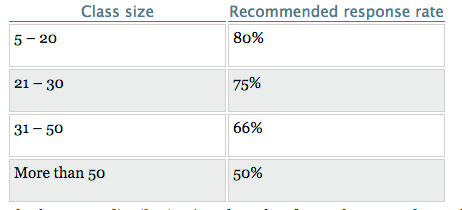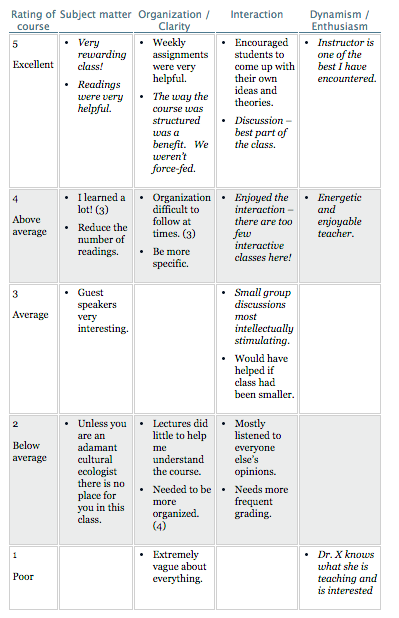Interpreting Numerical Feedback
Sort your CIS feedback forms into stacks based on the rating each student gave for the “Overall Course” rating. Beginning with the highest ratings first, examine student responses one stack at a time to help you put the results in perspective. For example, it is helpful to see if only the students who rate the course low say you are somewhat unorganized, or if those who rate the course high say the same.
Review the Results Summary Sheet, paying particular attention to the course response rate (# of students who completed the CIS / # of students enrolled in the course). CIS results may not be valid if the response rate is less than shown below:

The frequency distribution (number of students who respond to each option) for each question is also important. Note the questions that have multiple responses in the “disagree” and “strongly disagree” options. These are areas you may want to consider changing in some way.
Lastly, look at the mean (average) for each question. If a question has a mean of less than 3.5, you may want to consider making changes in that area. For specific suggestions, see The Research Behind Student Evaluations.
Compare your means to those of your college and the university. (For UT instructors only---EID required) If your means are lower than the means for your college/school, you may want to consider making changes in that area.
Chart changes over time by using a spreadsheet to graph the means for each question by year to identify trends and make timely changes.
Interpreting Written Feedback
Sort your CIS feedback forms into stacks based on the rating each student gave for the “Overall Course” rating, examining responses one stack at a time to help you put the results in perspective.
Categorize student comments using the grid below to help you analyze comments. Use the following categories (adapted from Hildebrand, Wilson & Dienst, 1971):
- subject matter – relates to the content of the course
- organization/clarity – relates to the skill in presenting and in providing clear explanations
- interaction – relates to instructor-group and instructor-student interaction
- instructor-group – includes rapport with the class as a whole, sensitivity to class responses, and skill at securing active class participation
- instructor-individual – includes mutual respect and rapport between the instructor and individual students
- dynamism/enthusiasm – relates to the flair and infectious enthusiasm that comes with confidence, excitement for the subject, and pleasure in teaching.
Written Comment Analysis Grid
Items in italics are positive comments; those not in italics are negative comments; numbers in parentheses indicate number of students who made similar comments.

In the example above, note how often “lack of organization” was mentioned and the course rating given by those students (4, 2, and 1). This instructor should consider how to become more organized because even students who rated the course above average indicated that more organization was needed.
Focus on general patterns and themes rather than individual comments. For example, if there are twenty comments praising your organizational abilities but only three that criticize them, your organizational skills are probably fine.
References
Hildebrand, M., Wilson, R.C., & Dienst, E.R. (1971). Evaluating University Teaching. Center for Research and Development in Higher Education, University of California, Berkeley.
Lewis, K. (Ed.) (2001). Techniques and Strategies for Interpreting Student Evaluations. New Directions for Teaching and Learning, No. 87, Fall 2001. San Francisco, CA: Jossey-Bass.
Theall, M. & Franklin, J. (Eds.) (1991). Effective Practices for Improving Teaching. New Directions for Teaching and Learning, No. 48, Winter 1991. San Francisco, CA: Jossey-Bass.

